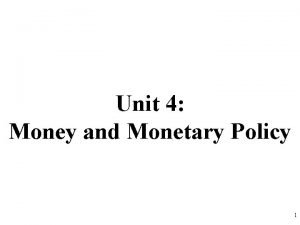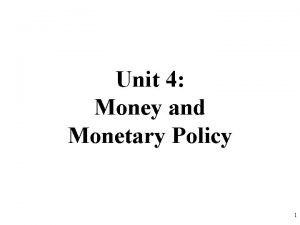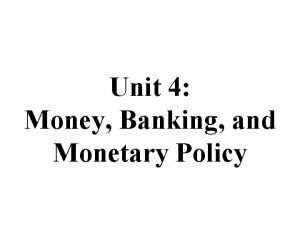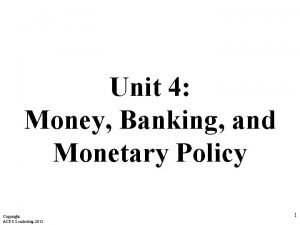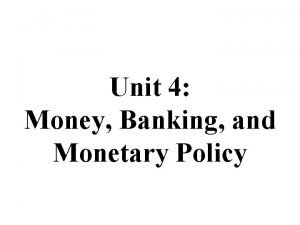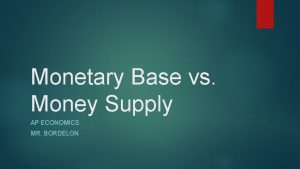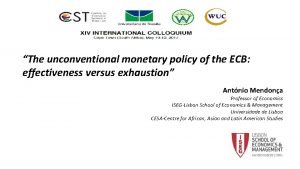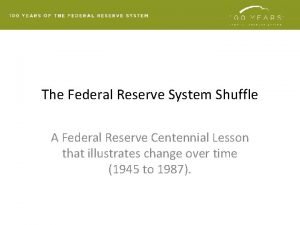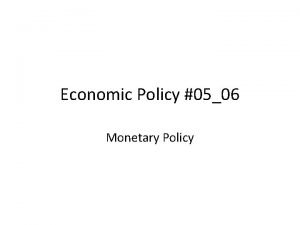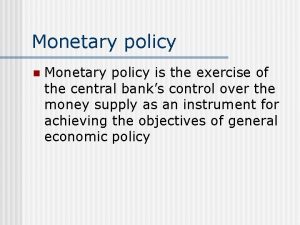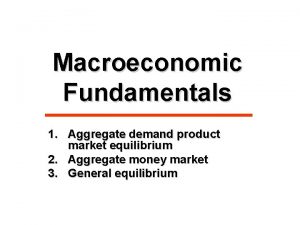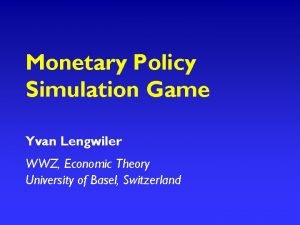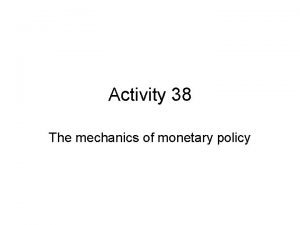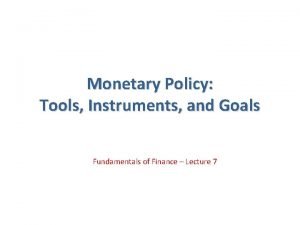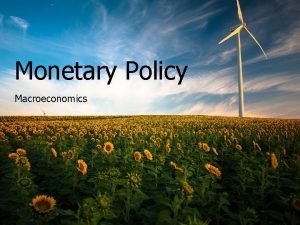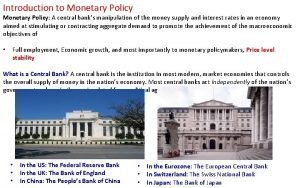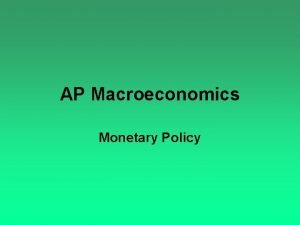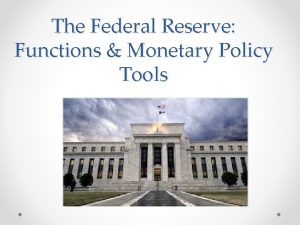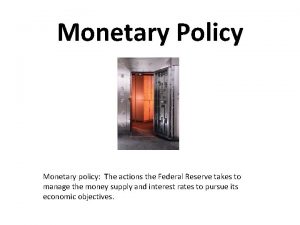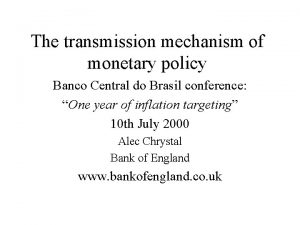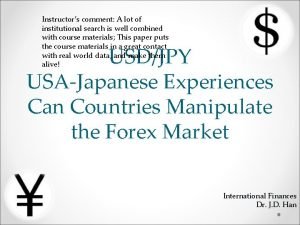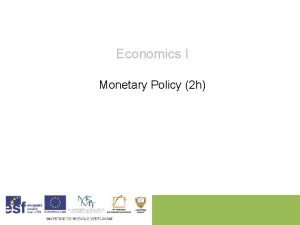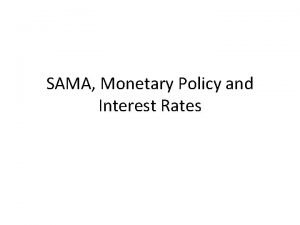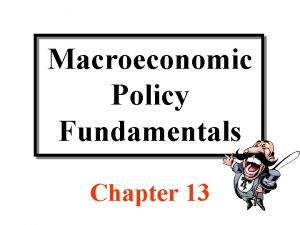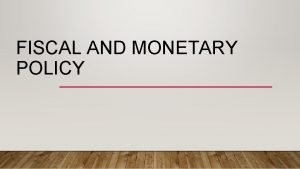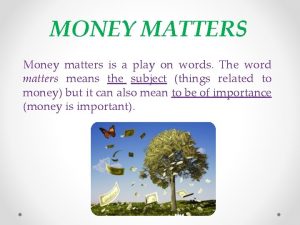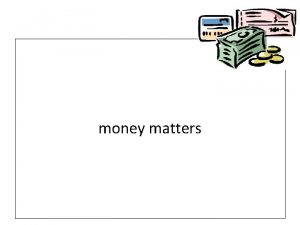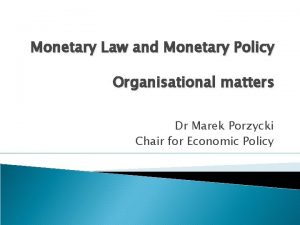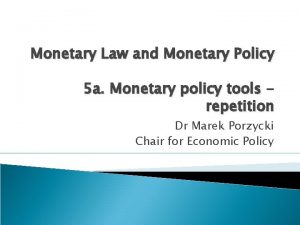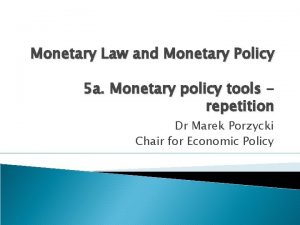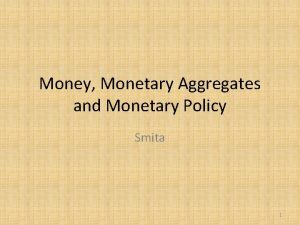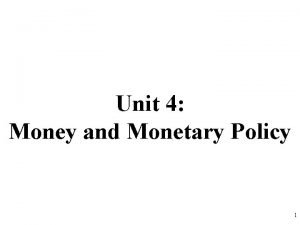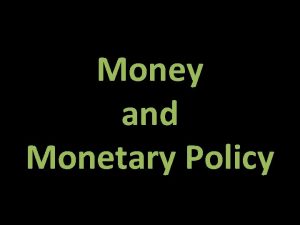Monetary Policy n Money matters so monetary policy



































- Slides: 35

Monetary Policy n Money matters, so monetary policy is important n Monetary policy is closely related to fiscal policy and to exchange rate policy n Monetary institutions also matter Thorvaldur Gylfason Tunis, February 2006

Outline Presentation in three parts 1. Monetary institutions 2. The main instruments of monetary policy 3. The role of money and credit in financial programming

1 Monetary institutions n Central banks n Commercial banks n Other financial institutions u. Central banks’ clients ü Government ü Commercial banks u. Commercial banks’ clients ü Households and firms

Central banks: Independent or not? n Most central banks, but not all, are owned and operated by the government n Central bank officials are public officials n Inflation in 1970 s and 1980 s raised concerns: were central banks being too willing to print money for short-sighted political purposes?

Central banks: Independent or not? n Governments may be tempted to instruct central banks to print money rather than raise tax revenue u. Major source of inflation, esp. in some developing countries n Several central banks have been made independent of politicians in order to immunize monetary policy from political pressures (US Fed, ECB, Bo. E, etc. )

Central banks: Independent or not? n Division of labor u. Government sets inflation target üPolitical task u. Central bank uses its instruments to achieve that target üTechnical task ü“Instrument independence” n Central banks do not make political judgments, not their business

Central banks: Independent or not? n Independence does not mean lack of accountability u. Courts and judges are supposed to be independent, yet accountable u. Central banks: Same story u. Free press: Same story n Accountability can be upheld through legally stipulated checks and balances

Commercial banks: Private or public? n Some countries have mainly private banks, others have a mixture of private and public banks, a few have only public ones n Private banks are usually better run u. Commercial vs. political motives u. Hence, privatization in banking sector u. Not obvious why governments should own and operate commercial banks

Commercial banks: Foreign or domestic? n Most countries have home-grown banks u. Domestic banks know best the needs of their domestic customers n Yet, foreign banks are becoming more common – e. g. , in Eastern Europe u. To increase competition so as to be able to offer more loans at lower interest u. To harness foreign expertise üForeign central bank governors: may not be such a bad idea!! (Israel, New Zealand, Botswana? )

Other financial institutions: Large or small? n Other financial institutions – financial intermediaries – play an important role n They create additional outlets for national saving, by households and firms u. They buy and sell bonds, facilitating noninflationary financing of fiscal operations u. They buy and sell stocks, facilitating the buildup of a strong private sector n Africa needs both

2 Instruments of monetary policy q Methods used by central banks to change the amount of money in circulation 1. 2. 3. 4. 5. 6. Open-market operations Reserve requirements Discount rates Printing money Direct instruments Persuasion

1. Open-market operations n Central banks conduct open-market operations when they buy government bonds from or sell government bonds to the public u. When they buy government bonds, the money supply increases u. When they sell government bonds, the money supply decreases n Foreign exchange market intervention also affects the money supply

2. Changing the Reserve Requirement n The reserve requirement is the amount (in %) of a bank’s total reserves that may not be loaned out to its customers u. Increasing the reserve requirement decreases the money supply u. Decreasing the reserve requirement increases the money supply

3. Changing the Discount Rate n The discount rate is the interest rate the Central Bank charges commercial banks and the government for loans u Increasing the discount rate decreases the money supply u Decreasing the discount rate increases the money supply

4. Printing money n The Central Bank can create money by extending loans to the government u How? By buying bonds from the government that issues them u Inflationary finance n Open-market operations are less inflationary than printing money u Hence the need for efficient financial markets that facilitate trade in bonds

5. Direct instruments n Ceilings on interest rates u Create excess demand for credit u Prone to abuse u Inefficient and unfair n Quotas on credit u Essentially the same effects as ceilings on interest rates

Problems in Controlling the Money Supply n Central Bank control of the money supply is not precise u Central banks do not control the amount of money that households and firms choose to hold as deposits in banks u Central Banks do not control the amount of money that commercial cy li o p l a bankers choose to lend Fisc icy l u Money is endogenous: M = D + R o p ate E ge n a h c x r

Rules versus discretion Benefits Rules Discretion Costs

Rules versus discretion Benefits Rules Discretion Flexibility to react to changing circumstances Costs

Rules versus discretion Benefits Costs Rules Discretion Incompetence, abuse of power Flexibility to react to changing circumstances

Rules versus discretion Benefits Costs Rules Discretion Incompetence, abuse of power Flexibility to react to Political business cycle changing circumstances

Rules versus discretion Benefits Costs Rules Discretion Incompetence, abuse of power Flexibility to react to Political business cycle changing Time inconsistency circumstances

Rules versus discretion Benefits Costs Flexibility to react to changing circumstances Incompetence, abuse of power Political business cycle Time inconsistency Lack of credibility Rules Discretion

Rules versus discretion Benefits Rules Tying one’s hands as a disciplinary device Discretion Flexibility to react to changing circumstances Costs Incompetence, abuse of power Political business cycle Time inconsistency Lack of credibility

Rules versus discretion Benefits Costs Rules Tying one’s hands as a disciplinary device Inflexibility that comes from locking the steering wheel Discretion Flexibility to react to changing circumstances Incompetence, abuse of power Political business cycle Time inconsistency Lack of credibility

3 Money and credit in financial programming History and targets q Record history, establish targets Forecasting q Make forecasts for balance of payments, output and inflation, money Policy decisions q Set domestic credit at a level that is consistent with forecasts as well as foreign reserve target

Financial programming right order e th in is th o D step by step 1) Make forecasts, set reserve target R* 2) 3) 4) 5) – E. g. , reserves at 3 months of imports Compute permissible imports from BOP – More imports will jeopardize reserve target Infer permissible increase in nominal income from import equation Infer monetary expansion consistent with increase in nominal income Derive domestic credit as a residual: D = M – R*

Financial programming thmetic ri a e th o d s t’ e L step by step 1) Make forecasts, set reserve target R* 2) 3) 4) 5) – E. g. , reserves at 3 months of imports Compute permissible imports from BOP – More imports will jeopardize reserve target Infer permissible increase in nominal income from import equation Infer monetary expansion consistent with increase in nominal income Derive domestic credit as a residual: D = M – R*

History Hypothetical example Known at beginning of program period: q M-1 = 70, D-1 = 60, R-1 = 10 Recall: M = D + R q. X-1 = 30, Z-1 = 50, F-1 = 15 Recall: DR = X – Z + F So, DR-1 = 30 – 50 + 15 = -5, so R-2 = 15 üCurrent account = -20, overall balance = -5 q R-1/Z-1 = 10/50 = 0. 2 üEquivalent to 2. 4 (= 0. 2 • 12) months of imports üWeak reserve position (less than 3 months)

Forecast for balance of payments X grows by 33%, so X = 40 BOP forecasts (in F grows by 40%, so F = 25 nominal terms) R* is set at 15, up from 10 (DR* = 5) Z = X + F + R-1 – R* = 40 + 25 + 10 – 15 = 60 Level of imports is consistent with R* because R*/Z = 15/60 = 0. 25 üEquivalent to 3 (= 0. 25 • 12) months of imports

Forecast for real sector Increase in Z from 50 to 60, i. e. , by 20%, is consistent with R* equivalent to 3 months of imports Now, recall that Z depends on PY where the increase in nominal income PY consists of a price increase and an increase in output Hence, if income elasticity of import demand is 1, PY can increase by 20% üE. g. , 5% real growth and 15% inflation üDepends on slope of aggregate supply schedule

Forecast for money Recall M = D + R If PY can increase by 20%, then, if income elasticity of money demand is 2/3, M can increase by 14% Recall quantity theory of money MV = PY Constant velocity means that %DM = %DPY = ˜ %DP + %DY (approx. ) Hence, M can expand from 70 to 80

Determination of credit Having set reserve target at R* = 15 and forecast M at 80, we can now compute level of credit that is consistent with our reserve target, based on M = D + R So, D = 80 – 15 = 65, up from 60 DD/D-1 = 5/60 = 8% üQuite restrictive, given that PY rises by 20% üImplies substantial reduction in domestic credit in real terms, to government or private sector

Financial programming step by step: Recap Sequence of steps Z = X + F + R-1 – R* R* MV = PY Z = m. PY M D D = M – R* Lower : le ro y e k a y la p F d n Forecasts of X a * R n e iv g r D fo forecasts mean lower

These slides will be posted on my website: www. hi. is/~gylfason Conclusion q. Money and credit play a key role in financial programming q. Not to be taken literally as a one-size-fits-all approach d n E The üCountries differ, so need to tailor financial programs to the needs of individual countries üEven so, certain fundamental principles and relationships apply everywhere
 Unit 4 money and monetary policy
Unit 4 money and monetary policy Macroeconomics unit 5 lesson 2 activity 45
Macroeconomics unit 5 lesson 2 activity 45 Unit 4 money and monetary policy
Unit 4 money and monetary policy Money market graph expansionary monetary policy
Money market graph expansionary monetary policy Unit 4 money banking and monetary policy
Unit 4 money banking and monetary policy Unit 4 money and monetary policy
Unit 4 money and monetary policy Unit 4 money banking and monetary policy
Unit 4 money banking and monetary policy Dana damian
Dana damian On old olympus towering tops a friendly viking
On old olympus towering tops a friendly viking Money matters topic
Money matters topic Monetary base vs money supply
Monetary base vs money supply Ecb unconventional monetary policy
Ecb unconventional monetary policy Lesson quiz 16-1 monetary policy
Lesson quiz 16-1 monetary policy What is inflation
What is inflation Objectives of monetary policy
Objectives of monetary policy Instruments of monetary policy
Instruments of monetary policy Monetary policy
Monetary policy Monetary policy simulation game
Monetary policy simulation game What are the objectives of monetary policy
What are the objectives of monetary policy Monetary policy baseline
Monetary policy baseline Moral suasion in monetary policy
Moral suasion in monetary policy Policy tools
Policy tools Expansionary monetary policy flow chart
Expansionary monetary policy flow chart Example of medium of exchange
Example of medium of exchange Monetary policy types
Monetary policy types Types of monetary policy
Types of monetary policy What is the meaning of monetary policy
What is the meaning of monetary policy Ano ang tight money policy
Ano ang tight money policy Monetary policy summary
Monetary policy summary Transmission of monetary policy
Transmission of monetary policy Conclusion of monetary policy
Conclusion of monetary policy Instruments of monetary policy
Instruments of monetary policy What are the objectives of monetary policy
What are the objectives of monetary policy Tools of monetary policy ppt
Tools of monetary policy ppt Expansionary money policy examples tagalog
Expansionary money policy examples tagalog Fiscal vs monetary policy
Fiscal vs monetary policy
